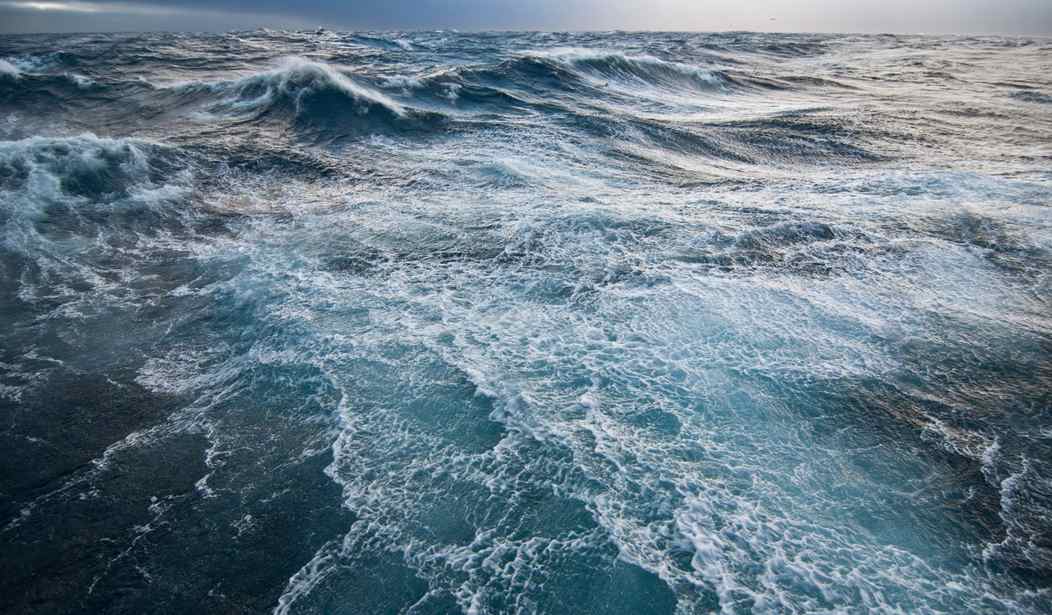The Asia Maritime Transparency Initiative, which has been following the construction of Chinese fortifications in the waters west of Palawan, recently caused a mild stir by publishing photographs of strange hexagonal structures and towers on Subi, Fiery Cross and Mischief reefs. The unfamiliar nature of these items obscured a more salient fact, which has alarmed even the New York Times: China has been turning a vast expanse of water into a fortified island zone on a scale unseen since World War 2. “China has been feverishly piling sand onto reefs in the South China Sea, creating seven new islets in the region and straining already taut geopolitical tensions. ”
Imagery from January compiled for a recent report by the C.S.I.S. suggests that China may be constructing a longer-range high-frequency radar installation on Cuarteron Reef that would help the country monitor air and ship traffic in the south, farther from the Chinese mainland.
Fiery Cross Reef is one of China’s most strategically important new islands, with an airstrip that is long enough to allow the country to land any plane, from fighter jets to large transport aircraft.
The overhead imagery showed impressive facilities. Fiery Cross for example boasted a 3000m airstrip, a harbor large enough to receive tankers and major surface combatants, 10 piers, air defense batteries, helipads, satcom facilities bunkers and buildings built on 667 acres of reclaimed land. Mischief Reef had besides an airstrip, 9 piers, satcom facilities and an access channel into its interior lagoon on 1,378 acres of reclaimed land. Subi, built on a 1,000 acres of reclamation, was potentially developing a 3000m airstrip, 11 piers, a 230 meter wide access channel into its inner lagoon and numerous other structures.
Yet massive though these installations were they were known quantities. It was the mystery objects which attracted the most press attention: hexagonal buildings and towers of no known purpose. AMTI wrote:
In addition to the rapid construction of hangars and other air support infrastructure at Fiery Cross, Subi, and Mischief reefs, other facilities have appeared on the features in recent months. Unidentified hexagonal structures are quickly being built at four locations on each islet—always oriented toward the sea. Work on these structures began in May at Fiery Cross and in July at Subi and Mischief. Each of the features is also now home to a set of three towers, one of which is larger than the other two. The towers do not have domes that would indicate radar or other sensitive arrays, and their location is not consistent, at least in relation to the runway or other infrastructure, across the three islets. These structures do not appear at any of China’s other outposts in the Paracels or Spratlys.
The BBC thinks the structure will form part of air defense facilities associated with the airstrips on the three Chinese bases. “China has embarked on a power projection drive in the region which will considerably extend the range of its naval and air capabilities.” Naturally it will need to defend them.
This military construction on the islands indicates that within a few months China will be in a position to deploy fighter regiments on the islands totalling nearly 80 aircraft – a formidable addition to its existing capabilities in the South China Sea. In addition, the bases will be able to host Chinese strategic bombers such as the H6-K, early warning and surveillance aircraft and long range transport and tanker jets.
Because such airbases are inherently vulnerable to attack, China appears to be deploying a sophisticated air defence network and the command and control infrastructure to protect its new island bases.
But one can never be sure. One of the dangers of mirror imaging is to assume the Chinese would do exactly what the BBC’s sources would do in Beijing’s place. When China’s maritime expansion first began the Obama administration saw the problem as one of freedom of navigation. By contrast China regarded the maritime question as a question of sovereignty. Mark Landler of the NYT reported on the problem in July, 2010: “Secretary of State Hillary Rodham Clinton, speaking at an Asian regional security meeting in Vietnam, stressed that the United States remained neutral on which regional countries had stronger territorial claims to the islands. But she said that the United States had an interest in preserving free shipping in the area and that it would be willing to facilitate multilateral talks on the issue.”
Though presented as an offer to help ease tensions, the stance amounts to a sharp rebuke to China. Beijing has insisted for years that all the islands belong to China and that any disputes should be resolved by China. In March, senior Chinese officials pointedly warned their American counterparts that they would brook no interference in the South China Sea, which they called part of the “core interest” of sovereignty.
The responses diverged according to perception. The Obama administration, viewing the issue through the lower priority prism of Freedom of Navigation, did not act with the same urgency as China, which saw it as an issue of China’s sacred borders. That’s why it came to this: to one side the problem was existential, to the other it got in line behind politics, ambition and more politics.
The same problem may afflict understanding the fortifications in the South China Sea. To the BBC the hexagons are air defense systems. But what do they signify to the Chinese? Air defense systems? Maybe.
In 1903 Erskine Childers wrote a classic of espionage fiction titled The Riddle of the Sands in the period of growing tension before World War 1. The book was premised on the idea that the Germans might invade Britain by doing something different. Much of the novel’s story revolves around the gradual realization that the apparently innocuous activity in the German Frisian islands was really aimed at facilitating a gigantic shore to shore amphibious assault on Britain by fleets of barges.
Carruthers, a minor official in the Foreign Office, is contacted by an acquaintance, Davies, asking him to join in a yachting holiday in the Baltic Sea. Carruthers agrees, as his other plans for a holiday have fallen through. …
Davies gradually reveals that he suspects that the Germans are undertaking something sinister in the German Frisian islands. This is based on his belief that he was nearly wrecked by a German yacht luring him into a shoal in rough weather during a previous trip. Davies is suspicious about what would motivate the Germans to try to kill him. Having failed to interest anyone in the government in the incident, he feels it is his patriotic duty to investigate further – hence the invitation to Carruthers. …
Carruthers finally puts the riddle together. The Germans are linking the canals and the railways, dredging passages through the shifting sands and hiding a fleet of tugs and barges. The only explanation is that they are going to secretly transport a powerful German army across the North Sea to invade Britain’s east coast.
The frenzied expansion by China into the reefs and shallows of the area is evocative of a modern day Riddle of the Sands. Something is going on which means a great deal to the Chinese, but what is it really? It is a mystery without detectives, with no Davies nor Carruthers. No one in the Obama administration seems really interested in finding out what the fortified island push is where no one ever runs out of time except maybe Social Security and public sector pensions. Rosa Brooks, a former civilian adviser to the Pentagon recently captured our state of distraction when she said: ‘we have no idea what war is’.
Kathy Gilsinan: The lines between “war and non-war are growing indistinct,” as you say. As a very basic question, what is war? And do you know it when you see it?
Rosa Brooks: I think we have absolutely no idea what war is. I think everything that frightens us, we now label war, more or less. And that’s a problem. As an analytic category, [war] has lost any clarity it might once have had…. you find yourself in meetings with military officials who are talking about running a program to prevent sexual violence in the Congo, and doing a big research project on how you most effectively dissuade foreign militaries from using sexual violence during conflict, and then you walk into another meeting and people are talking about how to promote micro-enterprise among Afghan women, it’s both kind of amazing and inspiring—that there’s this unbelievably diverse set of talents and people [and] projects. It’s amazing that the U.S. can still marshal so much talent and idealism. At the same time, it’s kind of scary, because you think, “Wait, whoa, is this the right place? Do we know what we’re doing? And what happens to the military as an institution when we’re asking it and expecting it to be all things to all people?”
Strange as it may seem it is perfectly possible to misplace even the concept of war to where it is everything and nothing. Maybe we have no idea what China is up to. Open thread: what do you think the hexagons and towers are?
Follow Wretchard on Twitter
Support the Belmont Club by purchasing from Amazon through the links below.
Recently purchased by readers:
Confessions of a Heretic: Selected Essays, Hard-hitting essays from a profound intellect. Philosopher Roger Scruton explores the conflict between the Christian-inspired Enlightenment and Islam, and attempts to find a remedy for the void at the heart of our civilisation. Why do we capitulate before everyone more ignorant than ourselves? Why do we turn immediately on all those who wish to defend our rooted values against whatever invading force has appeared over the horizon?
After America: Get Ready for Armageddon, According to author Mark Steyn, America has caught up with Europe on the great rush to self-destruction. What will a world without American leadership look like?
Margin of Victory: Five Battles that Changed the Face of Modern War, Col. Douglas Macgregor (Ret.) tells the riveting stories of five military battles of the 20th century, each one a turning point in history. Beginning with the British Expeditionary force holding the line at the Battle of Mons in 1914 and concluding with the Battle of Easting in 1991 during Desert Storm, this book teases out a connection between these seemingly isolated battles and teaches its readers an important lesson about how future battles can be won.
SPQR: A History of Ancient Rome By Mary Beard. Ancient Rome was an imposing city even by modern standards, a sprawling imperial metropolis of more than a million inhabitants that served as the seat of power for an empire that spanned from Spain to Syria. Yet how did all this emerge from what was once an insignificant village in central Italy?
Recommended:
Superintelligence: Paths, Dangers, Strategies, By Nick Bostrom. What happens when machines surpass humans in general intelligence? Will artificial agents save or destroy us? Bostrom lays the foundation for understanding the future of humanity and intelligent life.
Did you know that you can purchase some of these books and pamphlets by Richard Fernandez and share them with your friends? They will receive a link in their email and it will automatically give them access to a Kindle reader on their smartphone, computer or even as a web-readable document.
The War of the Words, Understanding the crisis of the early 21st century in terms of information corruption in the financial, security and political spheres
Rebranding Christianity, or why the truth shall make you free
The Three Conjectures, reflections on terrorism and the nuclear age
Storming the Castle, why government should get small
No Way In at Amazon Kindle. Fiction. A flight into peril, flashbacks to underground action.
Storm Over the South China Sea, how China is restarting history in the Pacific
Tip Jar or Subscribe or Unsubscribe to the Belmont Club










Join the conversation as a VIP Member